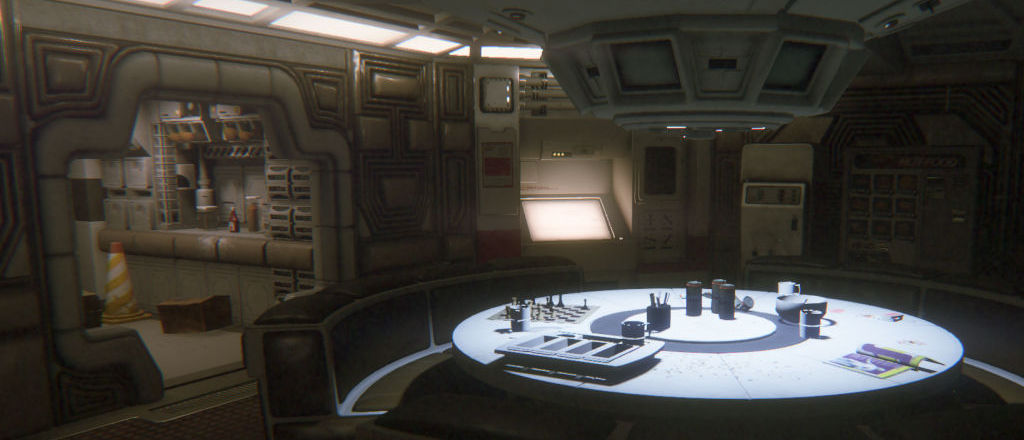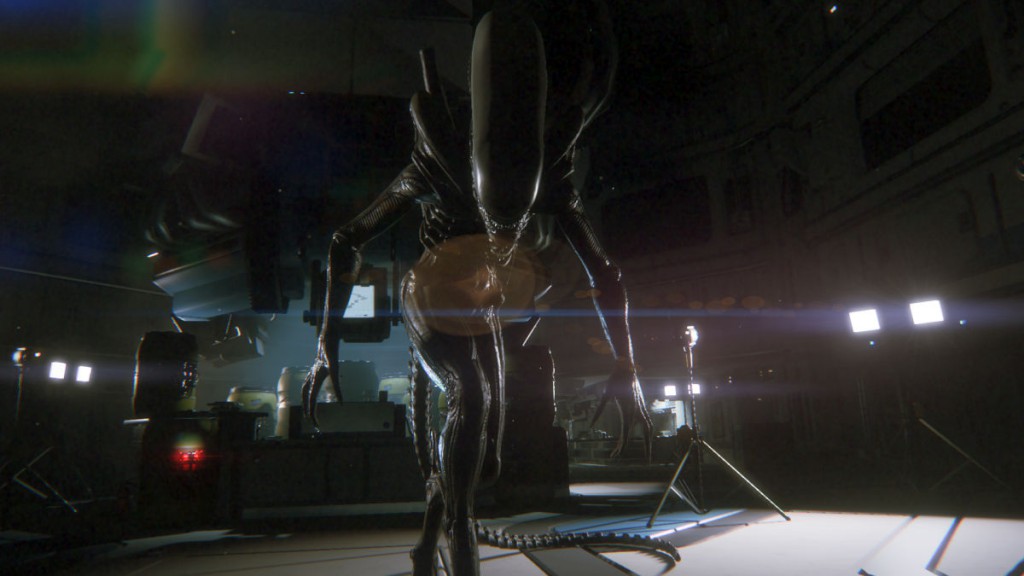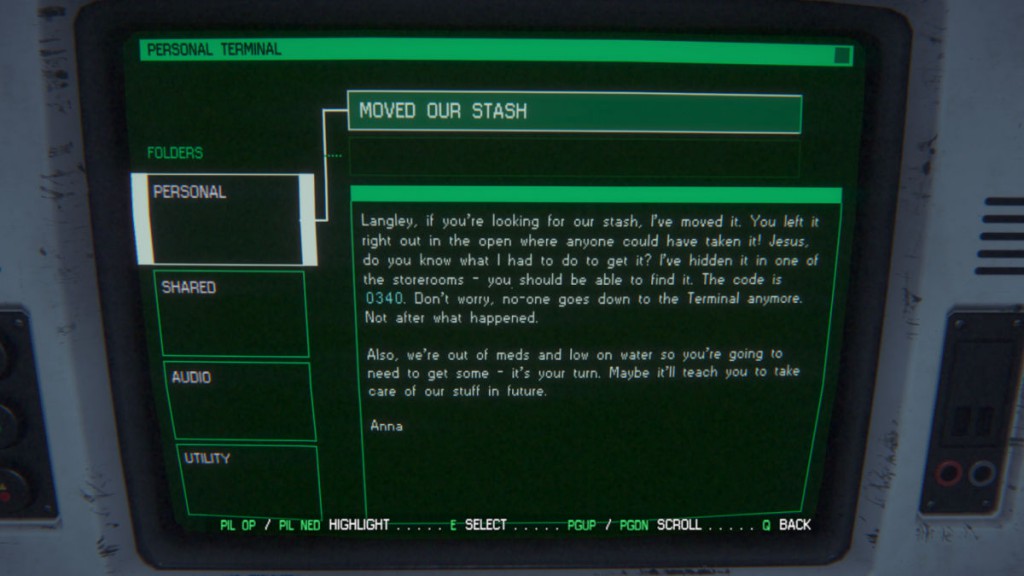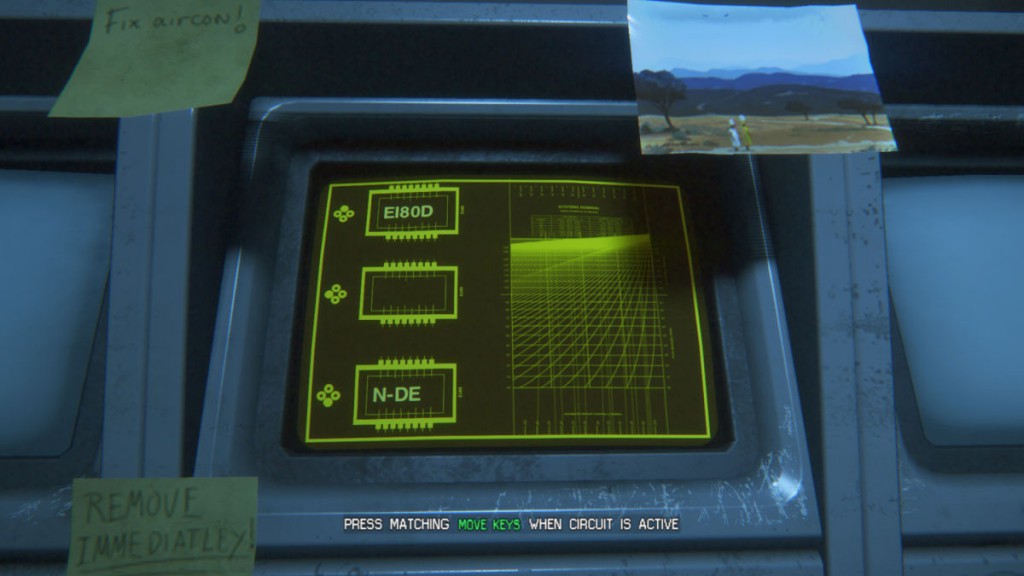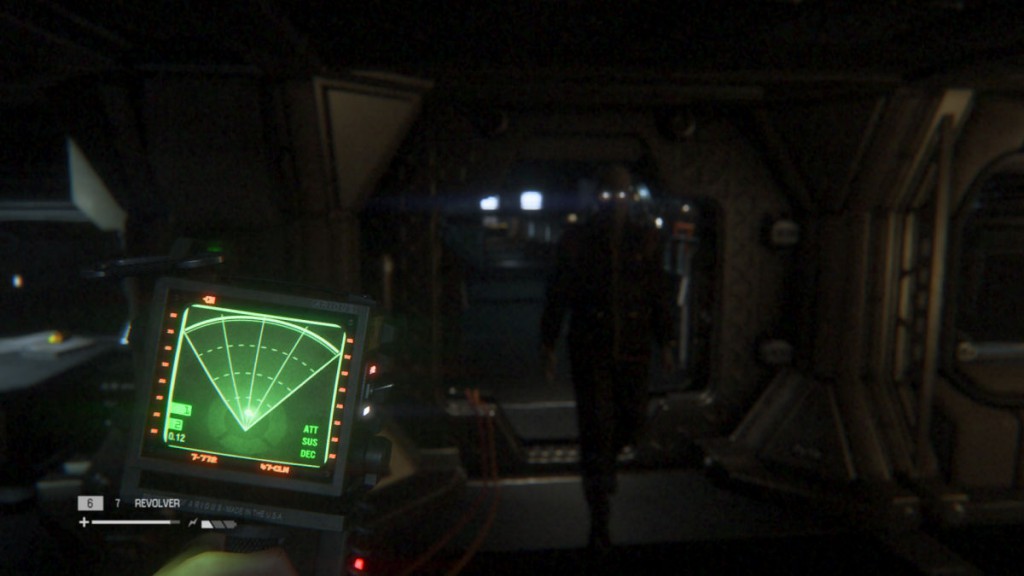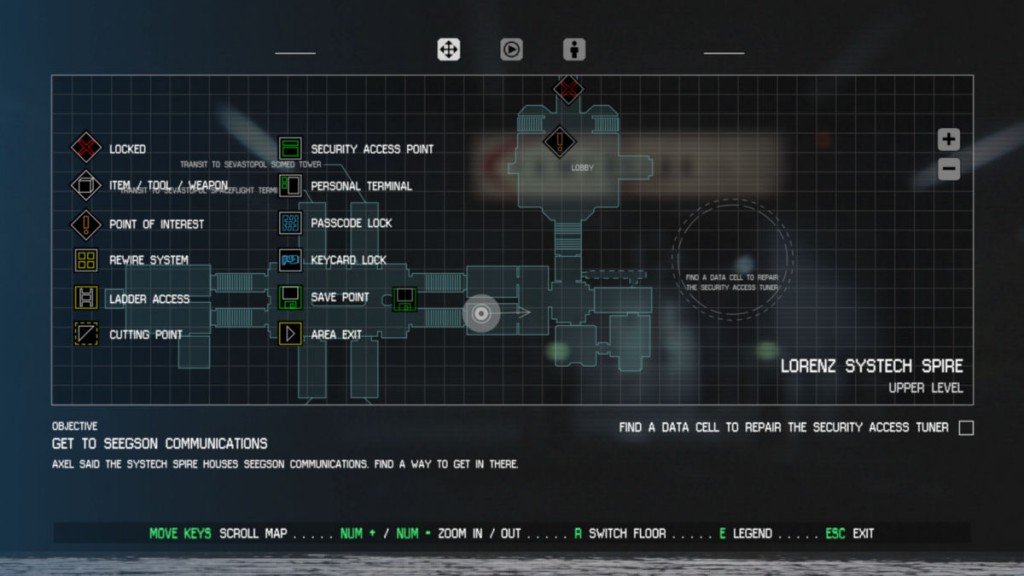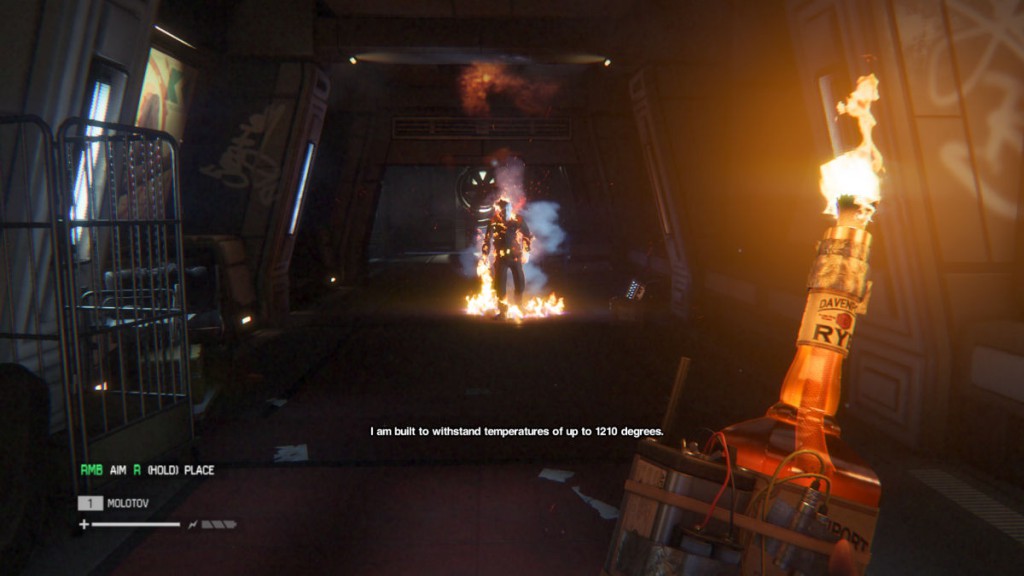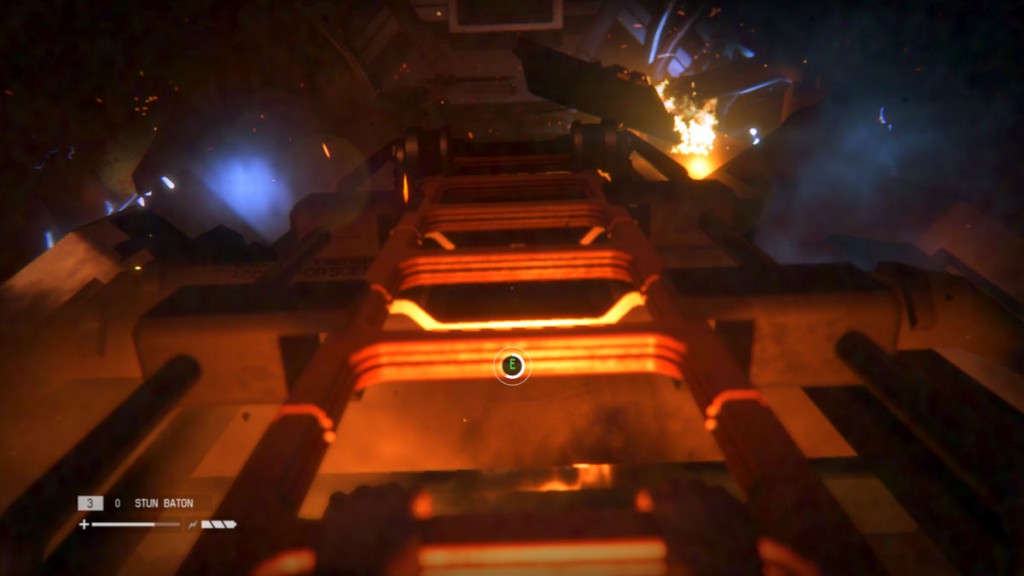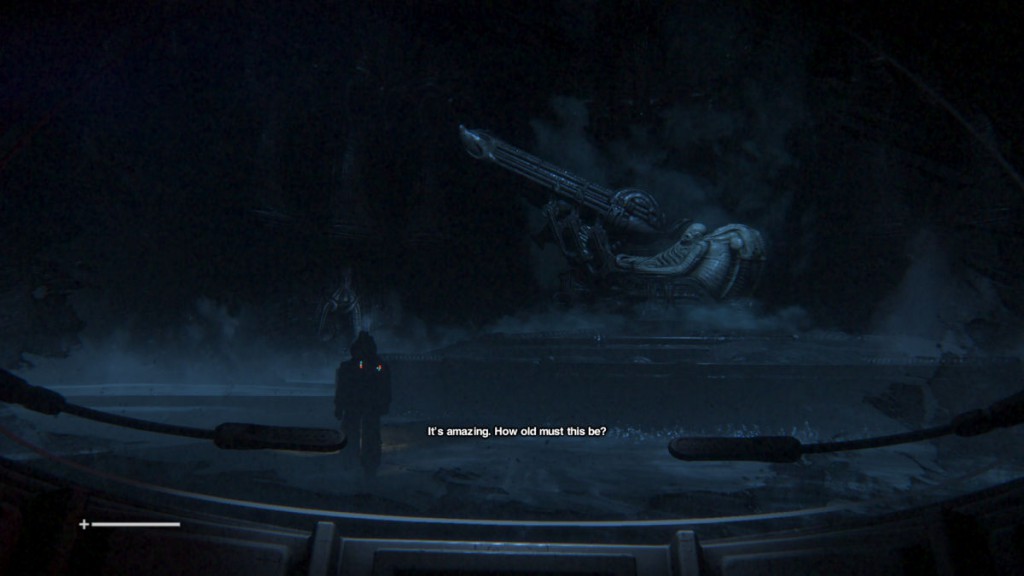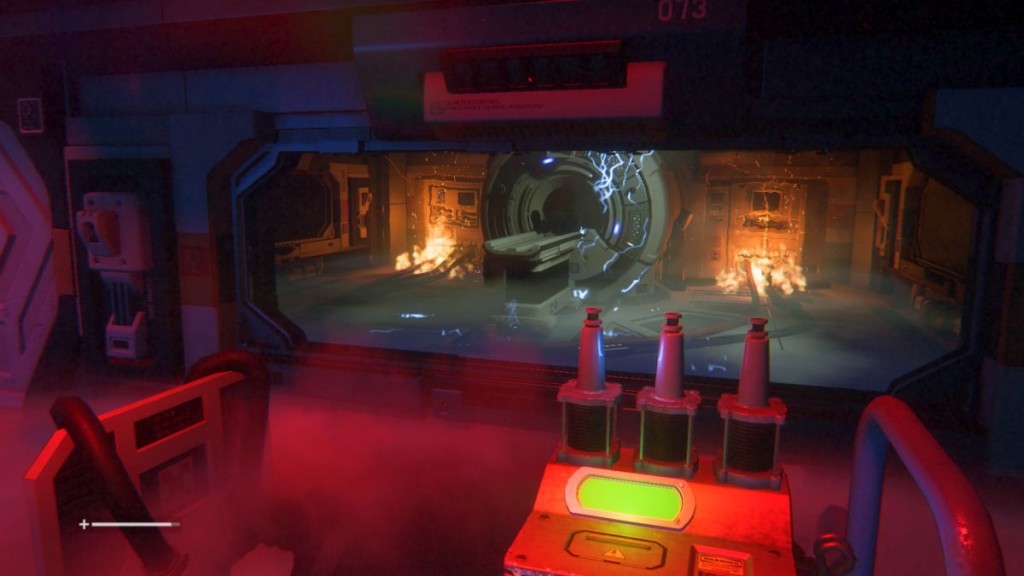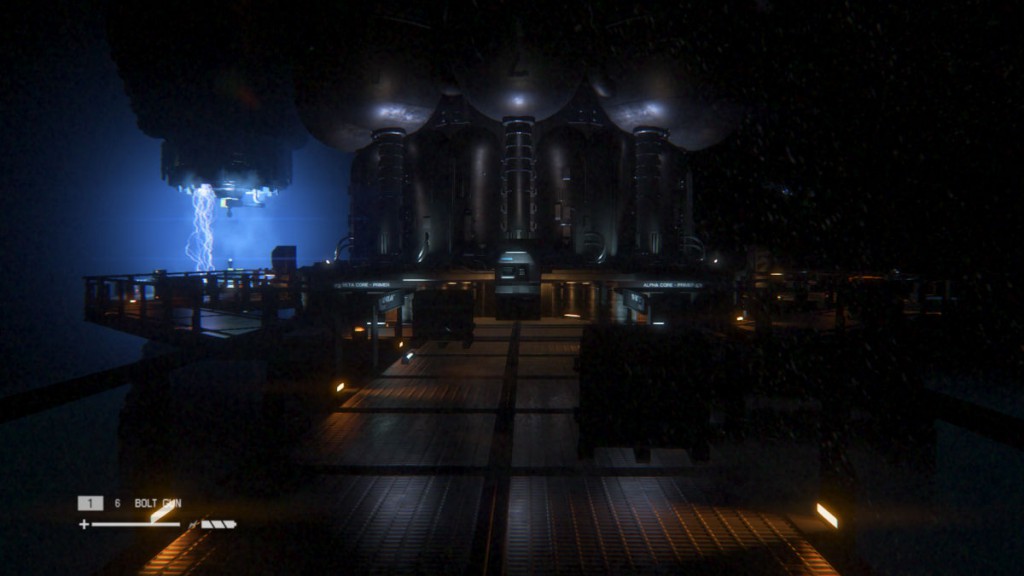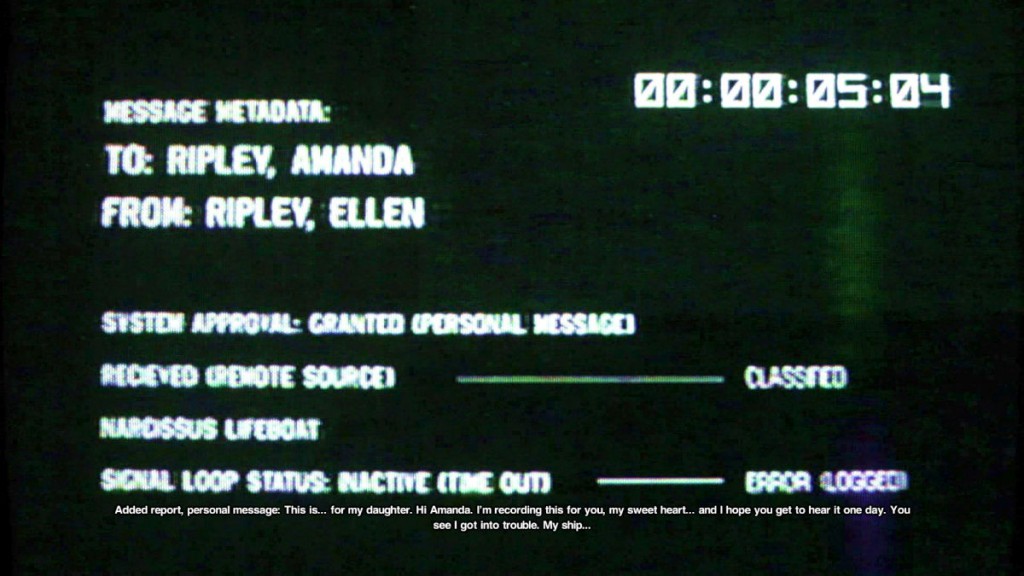Developer: The Creative Assembly | Released: 2014 | Genre: FPS, Horror
As a first person horror action/adventure, this game was quite true to the first movie and really managed to exude the same atmosphere. Especially the prefabs and corridors were an amazingly close call. In the beginning it also felt like a spiritual successor to System Shock 2, in part because of the ominous graffiti on the walls. And it was quite a looker. Lots of details, all high resolution textures, and a solid lighting style with small whiffs of smoke here and there.
The gameplay was mostly sneaking around, avoiding androids or the alien using various tools for opening doors and a bit of crafting for e.g. creating distracting bombs and health syringes. I could hide inside lockers or crawl through vents. Weapons were weak and ammunition sparse, and most of it would barely scare away the alien anyway. The androids in the game were also tough bullet sponges. Fighting one felt just as absurd as when Ripley fought Ash in the movie, just as it should be.
The levels were quite linear to begin with, but the later areas got bigger and with adjoining corridors. If the area felt particularly open with lots of options for moving around, chances were that the alien would be tagging along there as well. There was also a lot of backtracking, either to get back to a hub (such as the tram stations) or to open previously blocked doors with newly acquired hacking or cutting tools.
But it’s true what they all say – it was way too long (a whopping 19 missions) and sometimes relentless. I heard the rumors and prudently selected one of the lower difficulty levels, but still. There were actually a lot of levels where the alien wasn’t even present, but when it was, it felt like it was tethered to me. Sort of like if it could sense my aura and know not to go too far away.
Especially in a medical area this was so much over the top that I could barely concentrate on what I was actually supposed to do there.
The lower difficulty level eased up on this, but it was still quite noticeable. I bet having it leave completely for a few minutes at a time would have worked a lot better. That would have made me lower my guard, making the next sudden confrontation even more effective. Perhaps it wouldn’t even have had to leave physically. It could sort of go vacant in one of its roof vents, staring at a strikingly interesting vent wall bolt, then suddenly come to its senses and continue rumbling around loudly.
Minutia
I was in control of Amanda Ripley, daughter of that Ripley, and I immediately took notice of being able to see down her own legs. More first person games need to do that. Invisible limbs need to die, just like the mute protagonist. Sadly, she couldn’t jump. This was especially annoying in a hallway with a lot of rubble, most of which Ripley could easily have jumped or climbed over. Instead, she had to move a small vehicle and climb through a broken tube.
There were lots of Fallout 4 vibes in the beginning, actually. There were ghetto blasters with static to turn off, some of the hotkeys used for the mail terminals were almost as silly, and there was a similar loot menu on containers and bodies. It even had a nuisance right up Bethesda’s alley in the form of being forced to leave loot menus with a specific hotkey if you happened to be maxed out in an item type.
The crafting was the sort of doing it on the spot just by combining the component icons needed to create an item for the radial menu. No workbench needed here. I could find new blueprints for new stuff like e.g. noisemakers, smoke bombs, EMP mines, etc. Each time the item automatically added itself to the radial menu. It took me a little while to learn that pointing the mouse to a radial menu item chose it for first person use, while actually clicking the radial menu item meant crafting it.
There was a ton of small mini games. I really liked the one for hacking doors. A mouse cursor had to be moved around the edge of a screen for adjustment, and then a small number of pattern icons had to be selected within a countdown. Not too hard. Maybe the difficulty level added seconds there?
Some of the other mini games on static monitors weren’t always that logical, though. In a room with three monitors each with a mini game for establishing radio contact, one of them wanted me to tap direction keys in a timed manner. The timing wasn’t difficult at all, but the small icons with a clover of direction keys had dots inside three of these keys. At first that made me believe three keys had to be held down for each timed slot shown. After a minute of confuzzlement, it hit me that only the clear key in the icons indicated the direction, and then it was easy to complete. I’m not going to slap myself silly over that one, though. Having dabbled a bit in web development, I really believe those icons were misleading. Reversing the dots on the keys would have been much more logical.
It was also possible to rewire the electronics in various levels, like turning off lighting and cameras. This felt largely useless for a good while. Later, surveillance cameras could be turned off this way, but even then the rewiring panel was often right beneath the camera itself.
Also can’t say I was fond of discovering the old flashlight trope again with weak batteries running out fast, but it has now been part of a billion games since the dawn of dark corners, and it seems that game developers just can’t help loving it. For a while, it also seemed that it was bugged and wouldn’t allow me to pick up additional batteries even though the flashlight was almost depleted. Then quite a few missions later, I discovered that the batteries had to be fed into the flashlight by holding down its hotkey for a few seconds. Come on, why not just do that automatically as I pick them up?
Thank goodness for flares.
Other electronic doodads were e.g. clicking a big, beige map monitor to update the map, or the essential franchise motion tracker. The latter worked exactly as it should – audio clicks and big dots for movement on a crude monitor – but it had to be shown by holding down a key, after which the surroundings got slightly blurred. I would have preferred it to have been a fixed part of the HUD. Having to pull it out like that did make sense though, so I guess it’s just me dreaming for an easier time.
After my initial grunting and muttering about those manual save points – I would have preferred modern auto saving – they managed to annoy me even further by having some sort of wait timer after a recent use. At least it was a good call that the game had both a current and a previous save to load after dying.
And then there were those crazy key combinations for doing tool work, like removing the brace on a door using a big spanner. Hold down left and right mouse button simultaneously. Okay, done. Now hit a specific alphabetical key to finish it off. I get that the left and right mouse should match both hands gripping and the hotkey a direction for pushing or pulling, but it still felt unnecessarily convoluted. Why not just use one of those fast typing “close the circuit icon” hotkeys? Oh, wait, I get it. You want me to fumble this repeatedly while the alien is almost breathing down my neck.
One thing I actually thought worked well was the combination of melee and a firearm. Clicking left mouse button swings the spanner. Hold down right mouse button to aim the weapon and then the left mouse button as well to fire it. Just a shame that using e.g. a health syringe didn’t feel nearly as logical.
And I’m not entirely sure what to think of the expanded reload mechanic for firearms, either. A tap on the reload hotkey only adds one bullet. I have to hold down the reload button to max it out. But why would you ever want to reload just some bullets?
So suffice to say, the user interface was a hotchpotch of hits and misses. Not quite as bad as Fallout 4, but certainly a step in that direction.
The later areas opened up with adjoining areas and some backtracking wasn’t without problems either, especially when the area had several floors. The map wasn’t always clear on how to reach quest goals, and it wasn’t always cool trying to find an elevator what with the alien on an invisible leash. Sometimes I also goofed and chose the wrong elevator, then wondered about the quest goal right there on top of the same elevator. Oh, right. Wrong place.
Well, back and forth is twice the distance, as they say.
Without spoiling too much, there were of course also androids in the game, here lovingly called “Working Joes”. It was easy to spot them – typical movie android behavior with luminous eyes and rigid movements. They were surprisingly tough nuts, even when knowing what to expect from the movie. Melee attacks were almost useless without some form of distance effect to stagger them first, as they would just grab Ripley’s arm and hit back hard. Close up, which happened alarmingly often, gave me that fast typing “close the circuit icon” QTE hotkey. Gun shots? Bullet sponges. Fire? Couldn’t care less. One on fire even mentioned that they could resist up to 1210 degrees. (Fahrenheit or Celsius? I didn’t ask.)
And when they finally died, they made that disturbing gargle sound too like Ash did in the first movie.
Quite a weird temporary ceasefire came later in the game where I had to lure the alien into a different area. There were lots of androids here too, but for once they didn’t care about me and I could safely ignore them. The strange thing here is that the alien did the very same thing! I was hoping that I could have used some of these androids as a diversion for making it lag behind. So, why the sudden change of hostile heart, Mr. Alien? Was the smell of gears and wires too intense, perhaps?
Sneaking in general got better as soon as I got hold of that motion tracker, but I never thought it was awesome. Often it felt like more stealth tools were missing. The humans down a corridor might have been friendly and sometimes had to be checked out first. Oh, they weren’t? Pardon my fleeing! This seemed a bit random and made me wary of meeting new humans, but perhaps that was exactly what the developers wanted. Nevertheless it was sometimes necessary to check them out first because killing an ally or a civilian meant instant mission failure.
But worst was the wildly random AI of the alien. The way it rumbled around close by, popping out of roof holes, sniffing around, and then suddenly scurrying down a corridor, it could invalidate even the most impressive attempts at ghosting the level in an instant.
I thought Rock, Paper, Shotgun put it really well in a post from 2014 when they said:
Despite all of that praise, there are frustrations. Isolation is an unforgiving game. Unfair even. The alien will kill you, again and again and again. Progress can be slow and sometimes altering your tactics and using every tool at your disposal will seem pointless. Luck plays a role and passing a particular section can seem like an exercise in trial and error. The odds are stacked against young Ripley and even a fine understanding of the behaviours at play won’t be enough to prevent every single death.RPS
I probably won’t win any world champion clairvoyant medals for sensing the demise of Axel, the first human to escort Ripley, but come on! We had to trigger a mechanism by clicking a button at the same time from each side of a glass wall section! This one could be seen coming a galaxy away.
The medical area is notorious for being one of the most difficult areas in the game. I don’t blame people leaving the game at this point. Not only was the alien all over the place in a locked area, it also returned in several neighbor levels, and then there was an escape sequence where it could kill me instantly if I passed below a hole in the roof. Then there was an explosion and a big fire, with health draining because of asphyxiation. The first time I didn’t even get this part at all. Escape? Where!? All doors were locked! I choked and the last save point was far behind the previous section with the killing holes. Oh, joy.
After running around the fires getting addicted to health syringes, I finally noticed the ladder on top of a burning rubble. I didn’t think it was a logical place to go what with the rubble burning the most right there. Jumping up and escaping further upwards was of course brimming with QTE.
Unfortunately, some of the later alien levels were almost as annoying as the ones in the medical area. Especially in an area trying to trap it by locking up doors over several floors. That’s where the ceasefire androids were also present, by the way.
Getting to that part passed by a room that made one of the most convincing explosion impacts I’ve felt in a long time. An extremely loud bang and the entire screen going solid white. Because it was completely unexpected and the timing was so good, I almost jumped through the roof.
And then I turned down the volume. Just a tad.
Back at some sort of police station, Ripley interrogated a prisoner in his cell through the intercom. His story of how they brought in the facehugger was an entire level by itself, in his control. Three astronauts or so walking around on a stormy planet. Just like in the first movie, they find an alien spaceship, a skeleton pilot in a chair, and later one of the astronauts gets his facial hug. Although a refreshing change of pace, this part was way too similar to the movie. At least they should have tried something else than that pilot chair.
On the way to the alien ship on the murky planet, a fellow astronaut sometimes gave me a lift up to an edge. This is not the first time I have seen this maneuver in video games. Apparently it’s starting to become a new trope all of its own.
At around the tenth mission or so, Ripley managed to jettison herself into space through an airlock and reach some other part of Sevastopol. I’m not entirely sure what happened to the alien there. Either it got secluded or sucked into space too. Either way, that was the end of that as far as the game was concerned.
And what a relief it was! The next set of missions were almost a walk in the park compared to those stressful alien levels – even with the androids running amok and killing everyone. At least they could be zapped with EMP mines and then killed with a spanner. Or they went down with one shotgun blast to the face close up. If only they had kept using this type of android…
Finding the shotgun made me smile. The developers had placed an essential keycard below the shotgun, on top of a corpse. This meant that it was impossible to miss the shotgun if you wanted to open the door and continue. This is typical modern video game design – making sure you won’t miss vital stuff. Just like the way doors and new sections are made available after completing certain tasks.
Samuels, one of the fellows from the original trip to Sevastopol, turned out to be a Weyland-Yutani android. It’s one of those you can’t distinguish from a real human, unlike the Working Joes. He was also much stronger, demonstrated by him kicking one of their asses while I was witnessing it through a vent grill. I had a bad feeling about that…
Shortly after that there was a sequence where he locked himself into a small room and connected with the AI on the space ship through a CT scanner. Things went wrong, loud noises and dramatic music, and I had to turn off the power according to the coloring of wires on the floor. At least until the red lights turned on. Samuels then described what was near each power console. With all the power turned off, Samuels finally died a hero. A slightly touching moment.
Thank you, dear developers, for not turning him into the cliched boss fight I was afraid you would do.
But the relief of the alien being gone and “just having to fight androids” was soon twisted by me having to enter a section with supermen androids. First, I had to part with my firearms in a detector. Then, the area to come was swarming with this new type of androids in orange hazmat suits. They were impervious to EMP mines and the stun baton, required two shotgun blasts to the face, and felt pretty much impossible to kill. I tried going Rambo with a few of them in the beginning. Lets just say it wasn’t pretty. The developers really, really, really wanted me to sneak around instead.
In the domain of the orange hazmat suit androids I encountered a foggy room that required a gas mask. The gas mask was in a room right next to it. Ripley automatically put it on while going through the foggy room, then automatically took it off afterwards. I think this lasted for a few seconds of walking, after which the gas mask was never used again. I wonder what the prop designer of this gas mask felt about this?
There was also a big reactor level (funny how this kind of reactor is often sitting on top of a black void) again swarming with those hazmat androids. This led to a big nest area with alien eggs and their material all over the walls. There were facehuggers to burn and of course an alien wandering around in between as well. The facehuggers had to be dealt with quickly. Miss one and it was time to load a save game. No QTE, just immediate death. At least they always made a squealing sound upon arrival, so I knew when to prepare the flamethrower.
Leaving the nest area went past the big reactor level again, and here Amanda Ripley got the “brilliant idea” of overloading it to get rid of the alien nest once and for all. It was a lot of running around on metal bridges, turning on control panels in a sequence. There was a cluster of orange hazmat suit androids but luckily I had found some shotgun shells. It gave me some peace and quiet to fiddle with the control panels, but then the developers just respawned a new group of androids and I had to outrun them. Finally it was complete and I went to a control room and set it all off. But the aliens didn’t give a hoot and just spread themselves all over the place instead.
And then it hit me – Amanda actually haven’t been very successful with much in this game, has she?
First she tried luring the alien into a section and lock all the doors. Fail. Then she tried to purge the alien nest with the reactor. Fail. And then there’s the multitude of smaller tasks failing that had to be retried at a later time, like releasing the clamps for The Torrens.
I imagine that all these failures could make replaying the game a slightly uncool experience.
I found a really nice audio log from Nostromo with a message by Ellen Ripley for her daughter. Touching, actually. And voiced by Sigourney Weaver too. However, maybe it would have had an even bigger impact if it had been followed by a quiet walk down a few corridors to let it sink in, instead of a loud and dramatic hostage situation.
An then there was the escape. Loud explosions, tremors, fires. A hazmat suit android. One alien. Two aliens, one of which captured me before I managed to escape in a space suit. Amanda woke up tied to the wall, ready for a facehugger to arrive from one of the many eggs around her. I managed to break free and make my way back to the same airlock again.
I had to cross train track tunnels in danger of being run over by one of the amazingly fast trams. There were ladders and cavities to reach, often falling a few meters for extra dramatic effect. This section was the Tomb Raider reboot all over again. Also, the part with crossing a set of train tracks like that is another trope I’ve seen so many times in various FPS.
Oh, and now you can offer auto saving while dodging trams? Where were these earlier on in the game?
The ending – a dream of being taken by an alien on board The Torrens then stranded unconscious in space then presumably picked up – was a bit too dramatic for my liking. I would have liked a much more quiet ending, especially considering the fact that she’s supposed to live on for many decades to come.
This game was incredibly faithful to the first movie and written well enough for it to be considered Alien 1½. It had a fantastic horror atmosphere with first class lighting and sound. But it was also too long, at times too repetitive (lots of ladders to climb) and the alien felt like it was on a tight leash. There was a lot of luck involved when trying to dodge the alien.
But if I were to time travel back one month and talk to myself, I would absolutely recommend I play it. Just prepare for some frustrations, and keep to the low difficulty level. And that mini game clover icon? Think of it in a reversed manner.
| TitleLength | Dates | Diff / Cht | Save | Score | |
|---|---|---|---|---|---|
|
Alien: Isolation
2014 The Creative Assembly15h 16m 6
|
2016-01-02 2016-01-11 |
7
|


